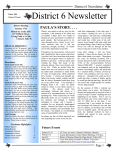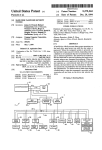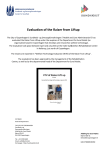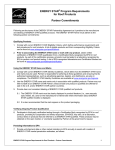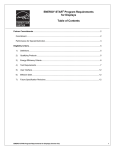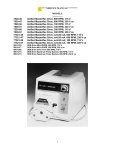Download Enabling New Mobile Applications
Transcript
www.digitalwatermarkingalliance.org WHITE PAPER ENABLING NEW MOBILE APPLICATIONS A COMPARISON OF TECHNOLOGIES EXECUTIVE SUMMARY There are three technologies with the potential to transform the mobile phone into an interactive link between the physical and digital worlds: digital watermarking, digital fingerprinting, and barcodes. With the increased power and capabilities of today’s mobile phones, systems that use these technologies have the capacity to identify the content of printed media and seamlessly connect the phone user to related resources in the digital world. This paper defines, discusses, and critiques digital watermarking, digital fingerprinting, and barcodes in the context of the mobile vision: an environment in which we interact with the media around us using our mobile phones. The flow of information through a prototypical mobile system is outlined in general terms, and the advantages and disadvantages of each type of system are identified, compared, and summarized. INTRODUCTION Recent trends have dramatically changed the way we use our mobile phones. These trends are both technological and cultural in nature, and point toward an environment in which the digital world increasingly merges with the physical world. What was once simply a cell phone has become a multi-purpose mobile computing device. Increased power and computing capabilities coupled with decreased size have made it possible to add functionality and combine previously separate operations into a single unit. Today, the cell phone is also a digital or video camera, an audio recorder, a motion sensor, a global-positioning system (GPS), an accelerometer, a compass, a personal digital assistant (PDA), and more. Increased processing power and functionality in mobile phones has been accompanied by increased coverage and bandwidth in mobile service networks. First generation networks supported only analog voice communications; second-generation (2G) networks transmit digitally and enable data transmission (text messages and email) as well as voice; third-generation (3G) networks provide sufficient bandwidth to support digital video and audio transmission. As mobile capabilities, capacity, and coverage have grown, the traditional roles of TV, radio, newspapers, and advertising are dramatically changing. Entirely new ways of interpersonal communication have arisen (e.g. MySpace, blogs, and Twitter) and people now use mobile phones to text their friends, upload pictures to their Facebook pages, download music from iTunes, check out videos on YouTube, and sometimes even talk. Consumers have come to expect information, entertainment, commerce, and communication to be available anytime, anywhere, and in any media. THE MISSING LINK As significant as these changes are, there has been a gap in this picture of instantaneous and complete access to the digital universe. In particular, a communication gap exists between the digital world and the physical world. Consider the following: While perusing Outside magazine, you notice an ad for a nice-looking mountain bike. You’d like to immediately visit the manufacturer’s web site to get more technical information, check the options, and find a local dealer. At a friend’s house you see a CD by an artist you like. You’d like to know where you can buy their CDs and what other CDs are available. You see a movie poster while riding the subway. You’d like to know where and when it’s playing. The common theme here is the need for a fast, convenient, dependable way to connect the physical world to the digital world. You can certainly search Google for the bike manufacturer, visit the artist’s website, and find the movie on Fandango. But these methods are often error-prone and time-consuming, and require you to type information into your phone or home computer. Even with the best of intentions to follow up later, most people will likely move onto the next thing, forgetting all about their interest at that moment. From the point of view of the bicycle manufacturer, movie producer, and musician, lack of follow-through means a commercial opportunity is lost. The makers of movies, music, and mountain bikes would benefit greatly from enabling an instant interaction between the consumer and their products. THE MOBILE VISION On one hand we have the bicycle ad, the movie poster, and concert tickets. On the other is the digital world containing useful information and enhanced experiences related to each of these items. In between stands a person holding a smartphone that can, in a sense, perceive and respond to the physical world around it. This is the promise of the technologies discussed in this paper — to enable mobile phones to respond meaningfully to media and objects in new, interesting, and beneficial ways —, bringing interactivity to previously static media such as posters or magazines. To provide these new experiences, the phone must be able to identify the media content or object. Imagine that your mobile phone could use its built-in camera to extract information from an image to identify it instantly. By pointing your phone at the bicycle ad, you could connect seamlessly to a wealth of associated resources — the price, technical specifications, options, dealers, store locations, and special offers. In this vision, all forms of printed content can become interactive and deliver exciting new consumer experiences that engage buyers with brands and open up opportunities for value-added services and increased revenues. A LOOK AT ENABLING TECHNOLOGIES Today, we are seeing the emergence of new mobile applications that do indeed link the physical and digital worlds to create rich, interactive experiences for consumers. But how is this being achieved? Several technologies have the potential to deliver these types of applications. The most widely recognized are digital watermarking, digital fingerprinting, and barcodes. This paper investigates some of the capabilities of each technology and discusses considerations for companies and developers evaluating options for mobile applications. DEFINITIONS A digital watermark is a digital code that can be embedded in all forms of content, generally imperceptible to people, but detectable by computers, networks, and other electronic devices. Conceptually it is analogous to the traditional notion of a watermark on paper, in which a barely perceptible mark is applied during manufacture that establishes the provenance of the paper on later inspection. Similarly, digital watermarks applied to digital content are persistent, staying with the content through manipulation, copying, format conversions, and so on. Digital watermarks are easily detected after distribution, enabling all forms of media and many objects to be given a digital identity. A digital fingerprint is a unique pattern that identifies content. A fingerprint is derived or computed from selected inherent properties of the content. For example, the fingerprints of audio and video content can be derived from salient features extracted from frequencies, timing, color, and luminosity. As with a human fingerprint, the fingerprint of unidentified content must be compared to a database of known fingerprints to identify the original content. Digital fingerprinting is a form of pattern recognition or image recognition, and some commercial systems use those terms to describe similar approaches. For this document, any system that identifies content based on its inherent properties is considered a fingerprinting system. A barcode is a visible, machine-readable pattern that encodes data according to a defined specification. One-dimensional (1D) barcodes are sets of parallel lines in which the pattern of line widths and intervening spaces encodes the data. In two-dimensional (2D) barcodes, data is encoded by various shapes of dots laid out in two-dimensional patterns. For historical reasons the term barcode includes both 1D and 2D systems. INHERENT CHARACTERISTICS As explained in this section, each technology considered here has, by its nature, certain inherent characteristics that determine its capabilities and potential applications. Watermarks: Comprise imperceptible data embedded into digital media All content carries some amount of information that is generally outside of human perception and appreciation. A digital watermark is a packet of data that alters content in a way that is imperceptible to human senses but easily detected by devices equipped with watermark reader software. Are applied to content prior to production A watermark can be applied to an image as long as it is in digital form. For printed material, this means before it is actually printed. Carry independent data The data encoded into a watermark is called the payload. The payload is usually independent of the content rather than derived from it. Instead it contains information to initiate some action as determined by the application. Depending on the application, the payload can provide a link to a remote database, trigger an immediate response on the device, or do both. For example, detection of the watermark in an advertisement could immediately trigger generation of a discount coupon for the product, link to and display the product’s web site, or both. Can identify specific instances of content Because a watermark contains arbitrary or independent data, it permits distinguishing between different instances of the same original content. For example, watermarks can identify different occurrences of the same advertisement in different magazines, at different times, in different regions of the country, and so on. Does not require a reference database to identify content As independent data, the payload identifies the content in which it is embedded regardless of the payload’s use for direct action, as a link to a remote database, or both. Fingerprints: Rely on the uniqueness of content A fingerprint is a mathematical encapsulation of selected inherent properties of content. For example, a fingerprint could be derived from the color boundaries and contrasts in an image. So, two images differ only if their contrasts and color boundaries differ sufficiently to generate different fingerprints. Are the same for all instances of the same content Because fingerprints are derived from the inherent properties of images, the same image generates the same fingerprint regardless of where it appears. Fingerprints cannot support distinguishing, for example, the different publications in which an advertisement might appear. Can be derived from content after it is distributed The fingerprint of content can be determined at any time during the life of the content, including after it is produced and distributed to consumers. So, for example, the fingerprint of an advertisement can be derived after the ad appears in circulation. Require a reference database for identification As with human fingerprints, the fingerprints of all content to be identified must be captured and incorporated into a reference database that must be accessible where content is to be identified. The reference database is typically too large to reside on a mobile phone, so resolving an unknown fingerprint requires sending it to a server for comparison to the database. Carry no independent data Being solely a calculated distillation of the properties of the content, a fingerprint contains no additional information. In isolation, a fingerprint conveys no meaningful or actionable information; it provides useful information only after resolution through the reference database. Barcodes: Are applied to content prior to production Barcodes must be applied to content before it is produced and circulated. Carry independent data Barcodes carry data that is independent of the content. A barcode can trigger immediate action, link to a remote database, or do both. Can identify specific instances of content Barcodes permit distinguishing different instances of the same content. Occupy space in content A barcode takes up space in an image. The space required includes a specified amount of white space around the barcode to ensure its recognition. In contexts such as magazine ads, space is valuable and allocating space to a barcode represents a trade-off of values. Are visually distracting In some visual contexts, such as grocery packaging, a barcode is an accepted part of the label and its visual impact is negligible. In other venues, barcodes could be a visually distracting addition to an image. It’s difficult to assess this impact objectively, but, for example, a barcode in a cosmetics ad in a high-end women’s magazine would detract from the appearance of the ad and the appeal of the product. Are widespread and well-understood Having been used for inventory tracking for some years, barcodes are a ubiquitous and accepted part of the retail landscape. They are well enough understood in that environment that many retail stores have adopted self-checkout lanes where consumers scan their own purchases. MOBILE SYSTEMS The general flow of information in a mobile application is similar across the three technologies, as illustrated in the diagram below. The details, however, differ in some important ways. Following the diagram is a step-by-step explanation that points out how watermarking, barcode, and fingerprinting systems differ at each step in the process. The process begins with the content owner, the holder of legal rights to the content, or their representative. In this discussion, a content owner is a corporate brand or marketing manager, movie producer, advertiser, or publisher — anyone with content they’d like to make more informative and beneficial to their audience. For content owners, the mobile identification system is an opportunity to fully monetize their content by engaging consumers in new and interactive ways. As detailed below, the four steps in the flow of content are Publish, Capture, Query, and Respond — all leading to action by the mobile phone user. 1. Publish In watermarking and barcode systems, content must be watermarked or barcoded during production, before publication. In a fingerprint system, the fingerprint of content must be calculated and added to the reference database before the fingerprint can be used for identification. This can be done either before or after publication. 2. Capture All three systems typically rely on a lightweight reader application to access content through the phone’s built-in camera. 3. Query or Trigger At this point in the process, there are several possibilities depending on the application and the technology: an action can be immediately triggered, a server can be queried for content identification, or both. Both watermarks and barcodes can carry data to trigger an immediate response, such as a flag to serve up a reward in a promotion. Such flags are typically one or two bits, only a small part of the entire payload. The additional payload data forms a query that’s transmitted to a remote database to identify the content and determine subsequent actions. Fingerprints carry no independent information, so triggering an immediate action is not an option in the absence of the reference database. In a few cases, the reference database may be sufficiently small and stable to reside on the mobile phone, but in most cases a fingerprinting system must query a server to determine a response. The query contains at least the calculated fingerprint, but it may also include the content itself for purposes of assessing the quality of the sample. 4. Respond The server identifies the content and uses the identity to retrieve the content’s metadata: information about the content. The concept of metadata is very open-ended: metadata can be any information whatsoever that’s needed by the intended application. For example, it could be the URL of a brand’s web site, a discount coupon for an immediate purchase, directions to a cinema, a user’s manual, a movie trailer, etc. All three types of system typically have a database of metadata that is accessed using the content’s identity. In a watermarking or barcode system, the watermark or barcode itself serves as an index into the metadata database, so the content’s metadata can be immediately retrieved and returned to the mobile phone. Because the watermark or barcode can identify the specific instance of the content, instancespecific metadata data can be returned. This enables targeted responses, such as serving up different web pages depending upon the magazine in which a particular ad appeared. In a fingerprinting system, the server must match the calculated fingerprint against the reference database to identify the content. Once (and if) a match is found, the identity can be used to locate metadata to return to the mobile phone. If multiple matches are found, the user may be asked to choose between the matches. At this point, the content has been identified, metadata has been returned to the mobile phone, and the consumer is informed, entertained, or engaged, and ideally is moved to act. EVALUATIONS OF MOBILE SYSTEMS So far, this discussion has defined three types of systems and shown how each generally operates to connect the physical and digital worlds. This section compares watermarking, barcode, and fingerprinting from a more utilitarian viewpoint, that of cost, efficiency, precision, accuracy, and usability. This section also discusses the required user education and impact on image quality for each system. To provide consistency and focus in our examples, this following discussion uses magazine advertising as the prototypical application — with the understanding that the concepts still generally apply to other printed media as well. COST The cost of adopting and using a mobile system includes the up-front costs of implementation plus the long term costs of use, maintenance, and expansion. An important consideration here is how the cost scales with growth in the volume of content to be tracked and identified. Watermarking is a well-established technology that has been applied to very large systems, so its costs are well understood. A watermarking system requires that watermark embedding be integrated into the production system, so there is an up-front cost to adopting watermarking. However, there is little additional cost after implementation, so the overall cost of a watermarking system is fixed and therefore amortized over the volume of content produced. As the volume increases, the cost per image decreases. Barcode systems are similar to watermarking systems with respect to cost. The costs are well known, including primarily the expense of setting the system up, but little more after that. So barcode system costs are also fixed and amortized over the volume of content to be produced and distributed. The cost of a fingerprinting system is more difficult to establish with certainty. In the prototypical implementation, the initial cost of a fingerprinting system is minimal because no embedding infrastructure is needed, but the overall costs of operating fingerprinting systems are not fixed. As the volume of fingerprinted content increases, the database storage requirements and processing power for searching the database both increase. With growth in the size and complexity of the system, its cost also increases. So, with increasing volume, the cost of maintaining a fingerprinting system will likely surpass the higher initial cost of watermarking or barcode systems at some point. Some trial fingerprinting systems have used a visual cue to signal that the content is interactive (see User Education below). In this case, there is an initial setup cost to a fingerprinting systems also, and this would continue to be the case as the market is being educated on using mobile phones to link from printed content to the web and more. EFFICIENCY Efficiency is the measure of how quickly a response is returned to the consumer’s mobile phone after the watermark, barcode, or fingerprint is extracted from the image. Because the transmission time between the mobile phone and the remote server is the same for all three systems, efficiency is a question of the time spent on the remote server to identify content and access its associated metadata. Given the payload from a watermark, only a single database indexing operation is required to access the related metadata. The time to index into a database can be accurately determined, and it remains essentially consistent regardless of the size of the database. So the efficiency of a watermarking system is known and constant regardless of the volume of content. Barcodes behave identically to watermarks with respect to efficiency: the efficiency can be accurately determined and it remains constant in the face of increased system volume. The efficiency of a fingerprinting system is determined primarily by the time required to search the reference database for a match to a given fingerprint. With the scale of existing systems, database search time has not been an issue to date. But as the volume of content grows and the reference database increases in size, the search time could increase measurably. How much it increases is dependent on the resources applied to the search operation. For example, additional hardware resources, improved search algorithms, and faster processors can all be applied to control search times. But it is difficult to evaluate at a system’s inception how increasing content volumes will be balanced by continued investments in database and computing resources. PRECISION OF IDENTIFICATION Because watermarks can be embedded in each individual copy of an image during production, watermarking permits the identification of specific instances of an image that appears multiple times in multiple locations. For example, a watermark can discriminate each individual appearance of an ad that appears in multiple issues of multiple magazines over a period of time. This provides the opportunity to measure the effectiveness of advertising in different magazines, at different times, on different pages, or even in different regions of the country. Barcode systems, like watermarking systems, permit distinguishing among multiple instances of an image appearing in multiple contexts. Fingerprinting can identify an image but not different instances of the image. Different instances of an image match the same fingerprint in the reference database, so it is not currently possible to determine from a fingerprint whether a given ad appeared in June in Outside magazine, July in GQ, or at any other time in any given magazine. LEGACY CONTENT Legacy content is content that has already been produced and may already be in circulation. In the case of mobile applications, watermarks must be embedded in images during the production of the magazine, and therefore cannot be used to identify images that are already in circulation. The decision to deploy a watermarking system in a given situation should be made early in the design and production process. Barcode systems also cannot be used to identify content already in circulation. Given that the inherent properties of an image are the same before and after production, fingerprints can be derived from already published content. This can be an advantage when an identification technology is being adopted later in the design and production process. However, in systems which use a visual cue to signal the existence of fingerprints (see User Education below), fingerprinting systems lose the advantage of applicability to legacy content. ACCURACY Accuracy is defined here as the certainty that the identification of content is correct. Watermarking systems are known to be highly accurate when a watermark is read successfully. The accuracy of watermarking systems is mathematically determined and has been demonstrated in practice in very large systems: if a watermark is detected and read, then the identity of the watermarked image is established. This is true of barcode systems also. Fingerprinting systems have demonstrated good accuracy in existing applications, but the scale of existing applications is relatively small, so the accuracy of fingerprinting systems on a large scale is unknown. Accuracy is dependent on several variables, including such things as the quality of samples from which fingerprints are derived and the similarity of images in the universe of comparison. How these variables are constrained and how they interact is not presently established for large scale fingerprinting systems. In the absence of a definite match, a fingerprinting system can be designed to return a set of close matches and offer the user the option of choosing one. USABILITY In this context, usability is the assessment of how easily the user can capture the information necessary to identify the content. It includes two primary aspects. One is the range of operating conditions — focus, lighting, and perspective, for example — in which the content is successfully identified. The second is the feedback that the user receives to indicate the information has been successfully captured. The effective range of operating conditions for successfully reading a watermark is usually narrower than fingerprinting. However, the watermark reader is able to determine when the conditions are met and can provide feedback informing the user that, first, the watermark is readable and, second, it has been read. This feedback is immediate — the user knows instantly when a watermark has been read. The operating constraints on barcode systems are similar to those on watermarking systems. Barcode systems have the additional consideration that the barcode must be entirely within the area covered by the lens. But, like a watermarking system, a barcode system can provide immediate feedback to the user that the barcode is successfully captured. The range of operating conditions is relatively less constrained in fingerprinting systems. Here the user has more latitude in capturing a fingerprint. The challenge in typical fingerprinting systems is that the system does not provide immediate feedback that a valid fingerprint has been extracted. Only if a match is found in the reference database can the system inform the user that the content is identified. And if the captured image was poor quality, a fingerprint system may respond, after the reference database is searched unsuccessfully, that the content is unknown even though the content is actually in the database. Absent other information, the user has no way of knowing whether to repeat the image capture to see if a better image will result in a match. USER EDUCATION Adoption of any of these mobile technologies will require educating the mobile phone user. Watermarks and fingerprints are covert by their nature and so do not inherently provide any clues to their presence and use. One approach to educating users is to make the presence of the fingerprint or watermark known to the user using a visual cue. This was tried with some success in a few early tests of fingerprinting in which selected ads in one issue of a magazine included a small icon indicating that the ad was interactive. The icon was introduced by a full-page advertorial explaining that taking a photo of a designated ad would enter the user in a drawing for prizes. Similar tests have been performed with watermarking. The presence of the visual cue also encourages the user to retry capturing the fingerprint or watermark if initially unsuccessful. The user will know to persist until receiving either the successful-capture feedback from the watermark reader or a match from the fingerprint reader’s database query. Barcodes have the advantage of being a familiar part of the retail landscape. However, there may be a challenge in getting consumers to transfer this familiarity to a new context and a different purpose. Users must learn that reading a barcode using a phone is different from scanning an item in the self-check-out lane at the grocery store: The phone must be held still and parallel to the printed material, as opposed to being waved over the ad in an attempt to read the barcode. AESTHETICS An advertisement in a major magazine represents a large investment and significant brand exposure, and brand owners want to ensure that their advertising budget is well-spent and the brand is wellrepresented. A barcode is by nature a visual cue and must appear somewhere in an image. Depending on the type of barcode and the context of its use, its presence may or may not detract significantly from the aesthetics of an image, but the question must be considered. Aside from aesthetic concerns, a barcode also occupies space in an image, including the space around the code that ensures it can be distinguished from the image. This is space which otherwise has some value, and the value gained through the use of the barcode must be balanced against the opportunity cost of the space it occupies. Being covert, neither watermarks nor fingerprints have any impact on the appearance of a printed image. The only aesthetic effect of watermarks and fingerprints may come from the presence of visual cues to their presence as described in the section above on User Education. SUMMARY With its gains in power and prevalence, the mobile phone holds the promise of becoming a means of interacting with our environment and enriching our lives through a range of new and enhanced experiences. We are beginning to see applications that enable our mobile phones to seamlessly connect items in our environment — signs, ads, posters, media of all kinds — with their complements in the digital world, providing access to all the information, resources, and benefits available there. But this vision is still in its early stages. While it is now possible to determine the identity of an ad or poster to access the associated rich digital world, mobile users must be educated on the use of new mobile applications and suppliers must ensure the process is seamless, simple, and reliable. Mastering these challenges will help achieve the mobile vision of turning the mobile phone into a handheld device that instantly bridges the physical and digital worlds. This paper has presented three technologies — watermarking, barcodes, and fingerprinting — that hold the potential to realize the mobile vision. Each technology has been defined, explored, and critiqued with respect to this vision. What have we learned? And where do we go from here? The following table summarizes the discussion so far. Summary of Mobile Technologies Watermarking Definition Identification Mechanism Deployment Cost Efficiency Precision of Identification Usability Immediacy User Education Aesthetics Barcodes Digital information embedded in content, imperceptible to people but detectable by digital devices Represents content by a Visible, machine-readable mathematical encapsulation pattern that encodes data according to a defined system Payload Fingerprint matched against Payload a reference database Widely and successfully deployed in critical nonmobile applications; Mobile systems in early phases of development Beginning to be deployed in An established feature of small-scale mobile the retail landscape; applications Beginning to be deployed in small-scale mobile applications Up-front implementation cost; Costs fixed and amortized over increases in volume Low initial cost; Cost increases with volume of content; Scalability unknown Up-front implementation cost; Costs fixed and amortized over increases in volume Relatively comparable; Efficiency fixed over increases in volume Relatively comparable; Undetermined over increases in volume of content Relatively comparable; Efficiency fixed over increases in volume Identifies individual instances of content Identifies all copies of content as identical Identifies individual instances of content Applicable to legacy content unless visual cues are used; Fingerprints must be entered in reference database before identification Not applicable to legacy content; Must be applied during production Not applicable to legacy content; Must be applied during Legacy Content production Accuracy Fingerprinting Very accurate; Accuracy fixed over increases in volume Accurate; Very accurate; Accuracy undetermined Accuracy fixed over over increases in volume of increases in volume content Relatively narrower range Relatively wider range of of operating conditions operating conditions Relatively narrower range of operating conditions Immediate user feedback Immediate user feedback Delayed user feedback Requires education of Requires education of users Users must be educated to users to presence and use to presence and use use in a new context Minimal impact Minimal impact High impact LOOKING FORWARD This table shows succinctly that each of these technologies has advantages and disadvantages in different areas. Given this, how do you select the best option for a specific mobile application? In the near term, while successful mobile applications could be achieved by each of the three technologies individually, possibly a combination could best satisfy all the requirements considered here: simplicity of use, dependable accuracy, ease of deployment, costs controlled in the face of growth in volume, aesthetics, applicability to legacy content, and identification of individual instances of content. In fact, it is possible for watermarking, barcode, and fingerprinting systems to coexist in the mobile ecosystem. And it is entirely feasible to install on one mobile phone the capabilities of identifying content by multiple approaches. These three technologies conveniently converge at a common requirement: the reader that resides on the mobile phone. To recognize digital images, watermarking, barcode, and fingerprinting systems all require the capture of content through the lens of the phone’s camera in technically and conceptually similar methods. One can easily imagine a single universal reader that scans content and identifies it from whatever evidence is available, whether watermark, barcode, or fingerprint. One can also easily imagine a culture in which consumers have learned to recognize cues that printed material is interactive and that a quick point-and-read with their mobile phones can produce interesting and valuable results. In the longer term, however, constraints and requirements may shift from those discussed here. One likely shift is the cultural assimilation of the interactive mobile phone, in which consumers will expect printed media to dynamically connect to the digital world. Another probable shift is that content owners and media producers will have adjusted their production systems to incorporate the infrastructure for marking content. Such shifts would work to the advantage of all mobile technologies, but digital watermarking would certainly benefit from the combination of cultural assimilation and adjusted production systems. These changes address the primary challenges to the adoption of watermarking and eliminate the advantages of the other technologies. In the long term realization of the mobile vision, digital watermarking certainly provides a complete and advantageous solution.















